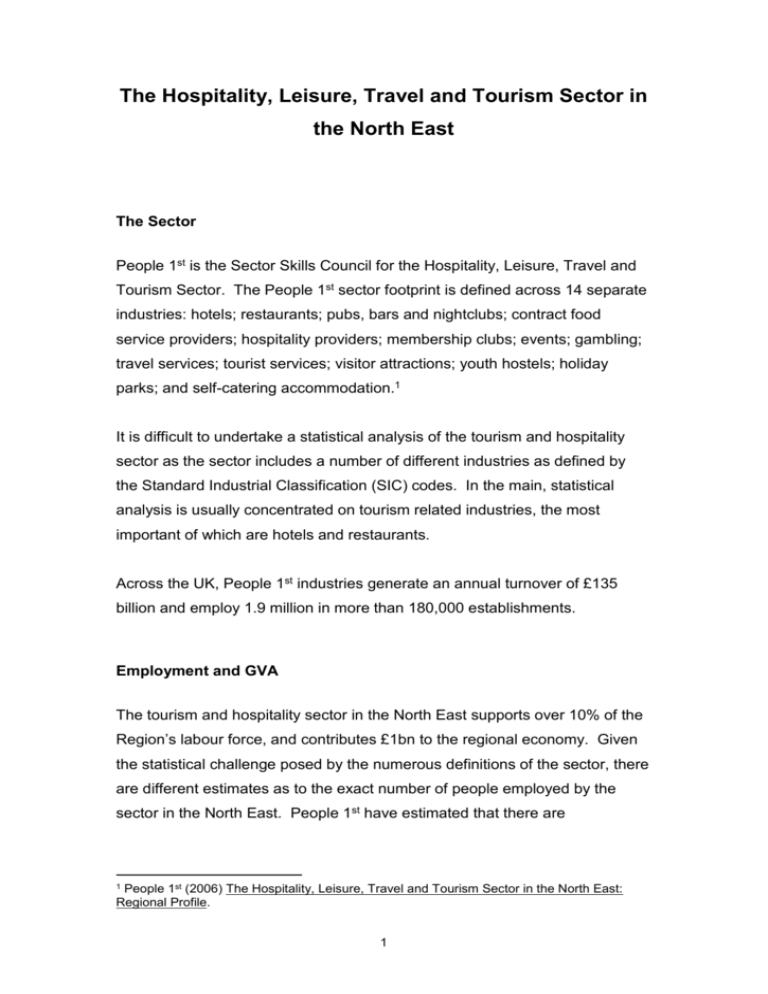North East Hospitality, Leisure & Tourism Sector Analysis
advertisement

The Hospitality, Leisure, Travel and Tourism Sector in the North East The Sector People 1st is the Sector Skills Council for the Hospitality, Leisure, Travel and Tourism Sector. The People 1st sector footprint is defined across 14 separate industries: hotels; restaurants; pubs, bars and nightclubs; contract food service providers; hospitality providers; membership clubs; events; gambling; travel services; tourist services; visitor attractions; youth hostels; holiday parks; and self-catering accommodation.1 It is difficult to undertake a statistical analysis of the tourism and hospitality sector as the sector includes a number of different industries as defined by the Standard Industrial Classification (SIC) codes. In the main, statistical analysis is usually concentrated on tourism related industries, the most important of which are hotels and restaurants. Across the UK, People 1st industries generate an annual turnover of £135 billion and employ 1.9 million in more than 180,000 establishments. Employment and GVA The tourism and hospitality sector in the North East supports over 10% of the Region’s labour force, and contributes £1bn to the regional economy. Given the statistical challenge posed by the numerous definitions of the sector, there are different estimates as to the exact number of people employed by the sector in the North East. People 1st have estimated that there are 1 People 1st (2006) The Hospitality, Leisure, Travel and Tourism Sector in the North East: Regional Profile. 1 approximately 87,147 hospitality, leisure, travel and tourism employees in the Region (Table 1). Table 1: Total employment in the hospitality, leisure, travel and tourism industry in the North East Industry Employment Number % Restaurants 16,054 18 Pubs, bars and nightclubs 21,008 24 Hospitality services 19,454 22 Hotels 7,302 8 Contract food service providers 9,106 10 Gambling 7,017 8 Travel and tourist services 5,891 7 Holiday parks and self-catering accommodation 347 0 Youth hostels 363 0 Visitor attractions 605 1 Total workforce 87,147 100 Source: Labour Force Survey, 2004/05 The Region’s hotel and restaurant industry employs (direct and indirect) approximately 44,000 people. According to the Annual Business Inquiry (ABI), in 2004 there were 63,500 North East hotels and restaurant employee jobs, and there was a 5% increase in total sector employee jobs in the Region between 2001 and 2004.2 The differential between persons employed and employee jobs can be explained by the fact that some individuals often have more than one job in the hotel and restaurant sector. Currently, One NorthEast is working on a mathematical model that will project the total number of people that will be employed in the tourism sector by 2010.3 The 2 Annual Business Inquiry 2004, 2003, 2002, 2001, Office for National Statistics ONE (2005) North East Tourism Strategy 2005-2010, Newcastle upon Tyne, One NorthEast. 3 2 outcome of this research exercise is expected by October 2006, and the forecast is for the sector to continue increasing its share of total employment in, and value to, the North East economy. The Agency believes that the sector in the North East has the potential to increase its proportion of the country’s tourism expenditure (currently 4%).4 Employment in the sector has grown slower in the North East compared with the national growth, and GVA per capita is estimated to be significantly below the national average. However, real GVA in the North East is estimated to have grown by 22% during the period 1998-2002. 8.7 million people visited the North East in 2004, spending an average of 2.5 nights in the Region. 74 million day visits were made in 2004. A third of the visitors from the UK came from the north of England and Scotland. Germany, Norway, the USA, France, the Netherlands, Ireland and Italy are key overseas markets for the North East. China and Japan are considered slightly less important for current and future trade potential, while other Asia and South and Central American countries are considered to be of some current importance with medium future potential. According to ABI (2004), there are approximately 7,044 hospitality, leisure, travel and tourism sector establishments in the North East.5 Over two-thirds of these establishments are pubs, bars and nightclubs and restaurants. Durham has the largest number of establishments in the Region. Over threequarters of establishments in the North East employ between 1 and 10 people. Occupational profile The majority of the industry’s workforce are female (69%), and there is an even split between those individuals who work on a full-time or part-time basis. The sector also employs a relatively young workforce. A fifth of 4 ONE (2006) Leading the Way: North East Regional Economic Strategy, Newcastle upon Tyne, One NorthEast. 5 Annual Business Inquiry 2004, Office for National Statistics. 3 workers in the North East are aged 16-19, while a further 18% are aged between 20-24. Core occupations tend to be those that are unique to the sector, such as travel agents, chefs and bar staff. Over half the workforce in the North East work in elementary occupations, such as kitchen assistants, waiting staff and bar staff (Figure 1). Figure 1: Occupational profile of the hospitality, leisure, travel and tourism sector in the North East 60 50 48 % 40 30 22 20 9 10 6 6 6 1 1 0 Managers and Associate Administrative Senior Officials Professional and and Secretarial Technical Skilled Trades Occupations Personal Service Occupations Sales and Customer Service Occupations Process, Plant and Machine Operatives Elementary Occupations Source: People 1st Skills Nearly a third of the sector’s workforce in the North East is qualified to level 2 and a third to level 3. Approximately 15% of the workforce has no qualifications, while 23% are qualified to either level 1 or entry level. A low proportion of people in the sector hold level 4 or higher qualifications. 4 According to People 1st, there are 1,585 vacancies in the core hospitality sector, with the largest number of vacancies for kitchen and catering assistants, bar staff, chefs and cooks. Nearly a fifth of hospitality and tourism firms have indicated that they have hard to fill vacancies, and 48% of the unfilled vacancies are attributed to a failure to find individuals with the appropriate skills. A third of employers have reported skills gaps. Average earnings The average wage in the hotel and restaurant industry is almost half the average wage for all industries in the North East (Table 2). This figure is skewed somewhat by the low level of part-time wages for hotel and restaurant staff in the Region. Full-time wages for men in the sector are above the average wage for all industries in the North East, roughly the same as the average for services, but below the average wage of those employed in manufacturing. The average wage for females employed in hotels and restaurants is only 60% of the average male wage. Female part-time workers earn 89% of the male part-time wage. Table 2: Weekly wages in the North East (£ pounds) Average: Full-time: Hotels and Hotels and Part-time: Average: Average: Hotels and Manufacturing All Services Industries restaurants restaurants restaurants Male 218.40 327.50 94.90 Female 132.40 239.20 84.60 All 164.40 416.80 Source: Annual Survey of Hours and Earnings (ONS) 5 330.40 311.40 Working time Full-time workers in hotels and restaurants work, on average, 40 hours a week, which is higher than the average working week for all sectors and workers in the North East (Table 3). Taking the average part-time wage in hotels and restaurants and then dividing this figure by the average hours worked per week, it is possible to calculate that the average hourly rate of pay for male and female part-time workers in the North East is £5.31. Table 3: Hours worked per week in the North East All sectors: Hotels and Hotels and Hotels and Average restaurants: restaurants: Full- restaurants: Part- Average time time 29 40 16.9 33.6 Source: Annual Survey of Hours and Earnings (ONS) Ethnicity and employment An emergent feature of the labour market in the North East is the growing participation of migrant workers from Central and Eastern Europe or what have been termed the A8 accession countries. In the ‘tourism sector’ the participation of such workers can be measured using the Home Office’s Worker Registration Scheme (WRS) (Table 4). Over half of registered workers in the North East tourism sector are Polish. The Czech Republic, Lithuania and Hungary are also significant host countries for migrant workers in the sector. However, the official figures are likely to have underestimated the exact number of migrant workers engaged in the sector. 6 Table 4: Worker Registration Scheme in the North East tourism sector6 North East TS TD SR NE DL Total 39 33 59 483 59 662 postcodes Registrations Postcode key: TS (Teesside); TD (Teesdale); SR (Sunderland); NE (Newcastle); DL (Durham) Source: Home Office WRS Research commissioned by the Northern TUC, and undertaken by the Centre for Urban and Regional Development Studies (CURDS), University of Newcastle upon Tyne, has revealed that the Black Minority Ethnic (BME) working population in the hotel and restaurant industries in the North East, according to the 2001 Census, stood at 6.6% of the total working population.7 Newcastle upon Tyne and Tees Valley had the largest percentage of BME workers in their respective hotel and restaurant industries. In Newcastle upon Tyne and Middlesbrough, the Chinese, Bangladeshi and Pakistani communities formed the majority of the BME working population within the sector. Contact Peter O’Brien, Regional Policy Officer, Northern TUC, 5th Floor, Commercial Union House, 39 Pilgrim Street, Newcastle upon Tyne NE1 6QE. Tel: 0191 227 554. Email: pobrien@tuc.org.uk 6 WRS applications approved between 01/05/2004 and 31/03/2006. CURDS (2006) Ethnicity and the North East Labour Market: A report for the Northern TUC, Newcastle upon Tyne, Centre for Urban and Regional Development Studies. 7 7





